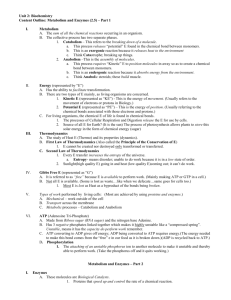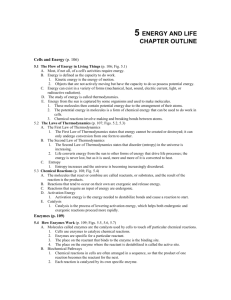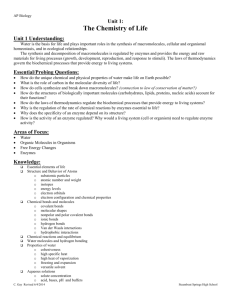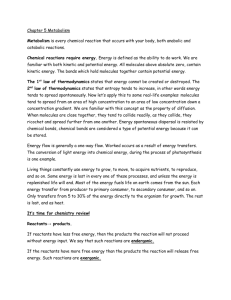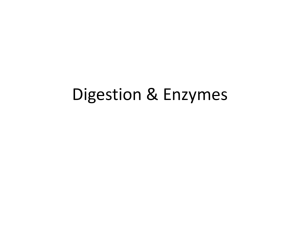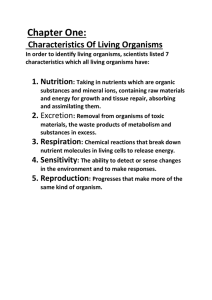PGS: 141 * 150
advertisement
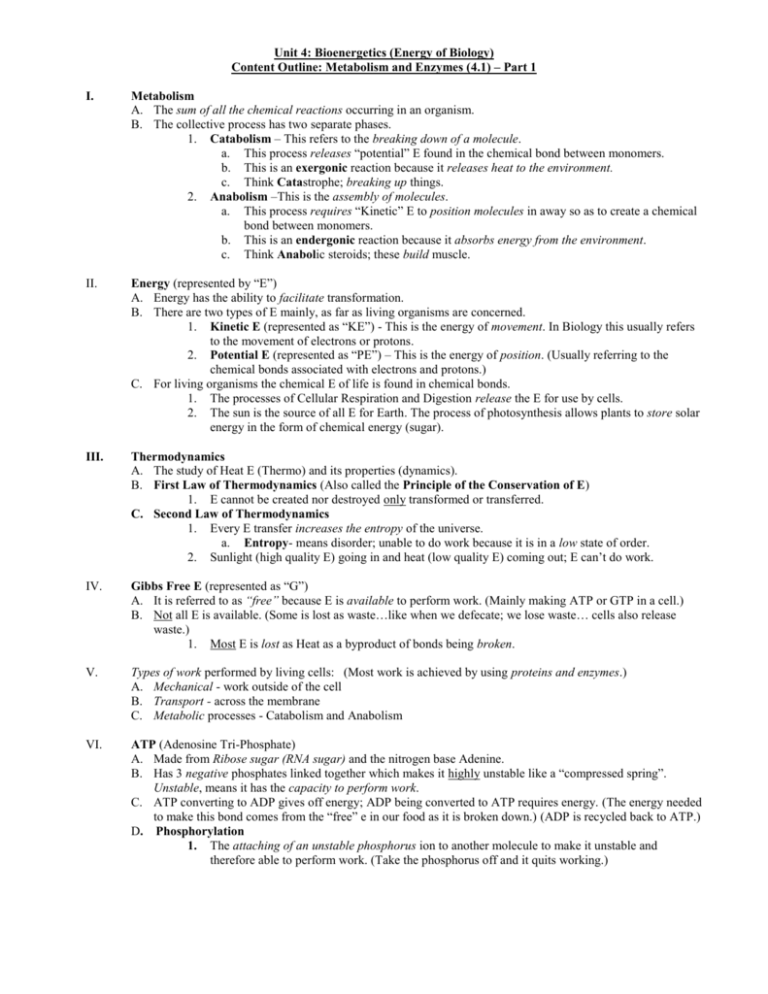
Unit 4: Bioenergetics (Energy of Biology) Content Outline: Metabolism and Enzymes (4.1) – Part 1 I. Metabolism A. The sum of all the chemical reactions occurring in an organism. B. The collective process has two separate phases. 1. Catabolism – This refers to the breaking down of a molecule. a. This process releases “potential” E found in the chemical bond between monomers. b. This is an exergonic reaction because it releases heat to the environment. c. Think Catastrophe; breaking up things. 2. Anabolism –This is the assembly of molecules. a. This process requires “Kinetic” E to position molecules in away so as to create a chemical bond between monomers. b. This is an endergonic reaction because it absorbs energy from the environment. c. Think Anabolic steroids; these build muscle. II. Energy (represented by “E”) A. Energy has the ability to facilitate transformation. B. There are two types of E mainly, as far as living organisms are concerned. 1. Kinetic E (represented as “KE”) - This is the energy of movement. In Biology this usually refers to the movement of electrons or protons. 2. Potential E (represented as “PE”) – This is the energy of position. (Usually referring to the chemical bonds associated with electrons and protons.) C. For living organisms the chemical E of life is found in chemical bonds. 1. The processes of Cellular Respiration and Digestion release the E for use by cells. 2. The sun is the source of all E for Earth. The process of photosynthesis allows plants to store solar energy in the form of chemical energy (sugar). III. Thermodynamics A. The study of Heat E (Thermo) and its properties (dynamics). B. First Law of Thermodynamics (Also called the Principle of the Conservation of E) 1. E cannot be created nor destroyed only transformed or transferred. C. Second Law of Thermodynamics 1. Every E transfer increases the entropy of the universe. a. Entropy- means disorder; unable to do work because it is in a low state of order. 2. Sunlight (high quality E) going in and heat (low quality E) coming out; E can’t do work. IV. Gibbs Free E (represented as “G”) A. It is referred to as “free” because E is available to perform work. (Mainly making ATP or GTP in a cell.) B. Not all E is available. (Some is lost as waste…like when we defecate; we lose waste… cells also release waste.) 1. Most E is lost as Heat as a byproduct of bonds being broken. V. Types of work performed by living cells: (Most work is achieved by using proteins and enzymes.) A. Mechanical - work outside of the cell B. Transport - across the membrane C. Metabolic processes - Catabolism and Anabolism VI. ATP (Adenosine Tri-Phosphate) A. Made from Ribose sugar (RNA sugar) and the nitrogen base Adenine. B. Has 3 negative phosphates linked together which makes it highly unstable like a “compressed spring”. Unstable, means it has the capacity to perform work. C. ATP converting to ADP gives off energy; ADP being converted to ATP requires energy. (The energy needed to make this bond comes from the “free” e in our food as it is broken down.) (ADP is recycled back to ATP.) D. Phosphorylation 1. The attaching of an unstable phosphorus ion to another molecule to make it unstable and therefore able to perform work. (Take the phosphorus off and it quits working.) Metabolism and Enzymes – Part 2 I. Enzymes A. These molecules are Biological Catalysts. 1. Proteins that speed up and control the rate of a chemical reaction. B. They are recycled; they are not consumed by the reaction. C. Enzymes are selective in what they will work with. We used to say they had a “lock and key fit” (old term); we now say it “fits like a glove or has an induced fit”(new term). 1. This is like putting on a latex glove… it stretches to conform to the shape of your hand. D. Enzyme names usually end with “ase”. The first of the name tells you what it works on. Ex. lipase = enzyme that breaks down lipids II. Free E of Activation (Activation Energy) A. This refers to the Free E used to start a chemical reaction in motion. (Essentially is the energy needed to get the molecules moving and positioned so that it is possible to combine or be torn apart.) B. The energy of activation is lowered by the action of enzymes. (Enzymes reduce by grabbing the molecule and positioning it correctly… we don’t have to wait for nature to do it.) 1. Enzymes also replace the need for heat in most chemical reactions (remember heat can make molecules move faster) so that organisms don’t burn up during metabolism. 2. Lower activation energy by: 1) Grab, Grab, Pair for anabolic reactions or 2) Grab, Grab, Tear for catabolic reactions III. Substrate A. This refers to the molecule that is being affected by the enzyme. (What the enzyme is grabbing and working on.) IV. Active Site A. This refers to the location where the chemical reaction(s) is taking place between the enzyme and substrate. B. It is an Induced Fit, which creates the Enzyme-Substrate Complex. (Complex means “more than one piece in the unit”.) C. The two parts are mainly held together by weak Hydrogen bonds D. By orienting the substrate molecules, the reaction rate speeds up. V. Environmental factors that can affect enzymes ability to work optimally. (“optimal” means “best” or “fastest”) A. Temperature – freeze/cold (cold things don’t move quickly) or Heat causing it to Denature (“unfold”). B. pH of the environment C. Salt concentrations D. The Optimal Conditions for most human enzymes: 1. 98.6˚F (35 - 40⁰C) 2. pH usually between 7.2 and 7.6 (The human body’s pH of blood is an average of 7.4.) 3. Remember, this is an unstable (dynamic) environment. There is an upper limit and a lower limit for enzymes. Beyond the limits, bad things begin to happen. So it is basically, trying to stay between the limits. The limits of “life”. VI. Inhibitors A. The name implies that these molecules negatively affect an enzymes ability to work optimally. These slow down or stop the rate of the chemical reaction. B. Two types of Inhibitors exist based on the location of the enzyme that is affected: 1. Competitive- These molecules compete for the active site. (This is because of similar shape.) a. These molecules slow down the reaction rate. (These molecules will be removed.) 2. Non-competitive –These molecules attach somewhere other than the active site causing the shape of the active site to change so the substrate can’t fit into it. a. These molecules cause the reaction to stop completely VII. Feedback Inhibition A. A product in excess shuts down the reaction that is taking place at an earlier point in the pathway. B. Prevents “waste” of precious materials and energy by not making more of what is not needed at that time.
